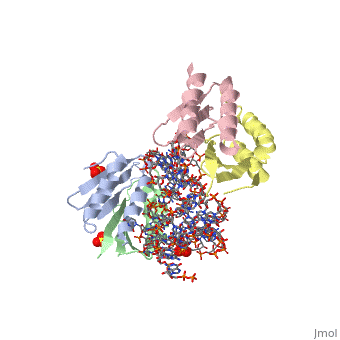Signal recognition particle (SRP) is a ribonucleoprotein which targets specific proteins to the endoplasmic reticulum (ER) in eukaryotes and the plasma membrane in prokaryotes. In eukaryotes SRP binds to the signal sequence of a newly synthesized polypeptide as it emerges from the ribosome. The binding allows for the coupling of the translation process to the translocation process. The SRP targets the nascent protein to the ER by docking into the SRP receptor[1]. The eukaryotic SRP which has GTPase activity, is composed of SRP9, SRP14[2], SRP19[3], SRP54[4], SRP68, SRP72[5] and 7S RNA. The prokaryotic SRP is composed of FFH (SRP54-like) and 4.5S RNA.
3D structures of signal recognition particleSignal recognition particle 3D structures
Updated on 05-May-2025
{{#tree:id=OrganizedByTopic|openlevels=0|
- Signal recognition particle
- 6y2z – hSRP54 NG domain 1-296 - human
- 6y30, 6y31 – hSRP54 NG domain (mutant)
- 1qb2 – hSRP54 M domain 326-434
- 4p3f – hSRP68 (mutant)
- 5m72, 5wrv – hSRP68 + SRP72
- 5wrw – hSRP72
- 1914 – mSRP9/SRP14 – mouse
- 1wgw – mSRP54 N terminal – NMR
- 2hug – AtSRP43 chromodomain 2 + SRP54 M domain – Arabidopsis thaliana – NMR
- 1x32 - AtSRP43 chromodomain 1 – NMR
- 5e4x - AtSRP43 chromodomain 3
- 3deo - AtSRP43 residues 85-267
- 3ui2 - AtSRP43 residues 84-327 + AtSRP54 RRKR motif
- 2w9j – SRP14 residues 1-91 – fission yeast
- 1ls1, 2j45, 2j46, 1ffh, 1ng1, 3ng1 - TaSRP54-like NG domain – Thermus aquaticus
- 2ng1 - TaSRP54-like NG domain (mutant)
- 2ffh - TaSRP54-like residues 1-425 (mutant)
- 1kvn, 1kvv – AfSRP19 (mutant) – Archaeoglobus fulgidus – NMR
- 2jqe – AfSRP54 M domain 313-433 – NMR
- 3dlu, 3dlv, 3dm5 – SRP19 – Pyrococcus furiosus
- 1j8m – AaSPR GTPase domain – Acicianus ambivalens
- 1j8y – AaSPR GTPase domain (mutant)
- 1qzx – SsSRP54 – Sulfolobus solfataricus
- Signal recognition particle complexes with RNA
- 1e8o, 1e8s, 5aox - hSRP9 + hSRP14 + 7S RNA
- 5m73 - hSRP19 + hSRP68 + SRP72 + 7S RNA
- 1ry1 - hSRP9 + hSRP14 + hSRP19 + hSRP54 + 7S RNA
- 4uyj, 4uyk - hSRP9 + hSRP14 + RNA
- 1jid – hSRP19 + RNA
- 3ktv - hSRP19 + RNA S domain
- 1mfq – hSRP19 + hSRP54 M domain + 7S RNA S domain
- 2j37 - hSRP19 + SRP54 + ribosomal proteins L23, L31, L35 + RNA – Cryo EM
- 2go5 – dSRP19 + SRP54 + hSRP receptor α subunit + mSRP receptor b subunit + ribosomal proteins L23, L31, L35 + RNA – dog
- 7obq, 7obr – dSRP19 + SRP54 + SRP68 + SRP72 + SRP receptor ubunit a + RNA – Cryo EM
- 4ue5 – dSRP9 + SRP14 + SRP54 + SRP68 + RNA – Cryo EM
- 3ktw - SsSRP19 + RNA S domain
- 1qzw – SsSRP + 7S RNA
- 1lng – MjSRP19 + RNA – Methanocaldococcus jannaschii
- 1l9a - MjSRP19 (mutant) + RNA
- 2v3c, 3ndb, 4xco - MjSRP19 + MjSRP54 + 7S RNA
- 2iy3 – TaSRP54-like + RNA - EM
- 1dul, 1hq1, 2pxp – EcSRP54-like C terminal + RNA – Escherichia coli
- 3lqx - EcSRP54-like + RNA + Co-hexamine
- 2xkv - EcSRP54-like NG+M domains + 4.5SRNA – Cryo EM
- 2xxa - EcSRP54-like residues 1-433 (mutant) + cell division protein FtsY residues 196-497+ 4.5SRNA
- 7o9f, 7o9g, 7o9i - EcSRP54-like residues 2-299 + ppGpp
- 3zn8 - EcSRP54 NG domain + cell division protein FtsY residues 201-495+ 4.5SRNA + dipeptidyl aminopeptidase B
- 2pxb, 2pxd, 2pxe, 2pxf, 2pxk, 2pxl, 2pxq, 2pxq, 2pxt, 2pxu, 2pxv - EcSRP54-like C terminal + 4.5SRNA domain IV (mutant)
- 2j28 – EcSRP54-like + 70S ribosome – Cryo EM
- 4ue4 – BsSRP M domain + FtsQ signal sequence + RNA - Bacillus subtilis
- 7o5b – BsSRP in 70S ribosome + ppGpp – Cryo EM
- Other signal recognition particle complexes
- 5l3q, 6y32 – hSRP54 + SRP receptor subunit α
- 3dep - AtSRP43 residues 85-267 + polypeptide
- 5e4w - AtSRP43 chromodomain 2-3 + thioredoxin + ALB3 tail
- 5l3r - AtSRP54 + cell division protein FTSY
- 1jpj, 1jpn, 2c04 – TaSRP54-like NG domain + GMPPNP
- 1o87, 2c03 - TaSRP54-like NG domain + GDP
- 1okk, 1rj9, 2cnw - TaSRP54-like NG domain + cell division protein FtsY
- 2j7p - TaSRP54-like NG domain + cell division protein FtsY + GMPPNP
- 5l3s - SsSRP54 + cell division protein FtsY
- 3kl4 – SsSRP54 residues 2-432 + polypeptide
- 5l3v - SsSRP54 + GDP
- 7epk - SRP54 + GDP – Aeropyrum pernix
- 4c7o – EcSRP + FtsY + SRP RNA
}}
References
- ↑ Halic M, Beckmann R. The signal recognition particle and its interactions during protein targeting. Curr Opin Struct Biol. 2005 Feb;15(1):116-25. PMID:15718142 doi:http://dx.doi.org/10.1016/j.sbi.2005.01.013
- ↑ Bovia F, Fornallaz M, Leffers H, Strub K. The SRP9/14 subunit of the signal recognition particle (SRP) is present in more than 20-fold excess over SRP in primate cells and exists primarily free but also in complex with small cytoplasmic Alu RNAs. Mol Biol Cell. 1995 Apr;6(4):471-84. PMID:7542942
- ↑ Dean KA, von Ahsen O, Gorlich D, Fried HM. Signal recognition particle protein 19 is imported into the nucleus by importin 8 (RanBP8) and transportin. J Cell Sci. 2001 Oct;114(Pt 19):3479-85. PMID:11682607
- ↑ Gowda K, Black SD, Moeller I, Sakakibara Y, Liu MC, Zwieb C. Protein SRP54 of human signal recognition particle: cloning, expression, and comparative analysis of functional sites. Gene. 1998 Jan 30;207(2):197-207. PMID:9511762
- ↑ Lutcke H, Prehn S, Ashford AJ, Remus M, Frank R, Dobberstein B. Assembly of the 68- and 72-kD proteins of signal recognition particle with 7S RNA. J Cell Biol. 1993 Jun;121(5):977-85. PMID:8388879
| |
